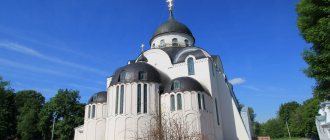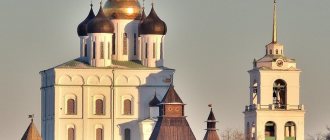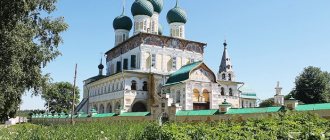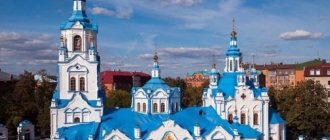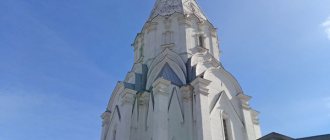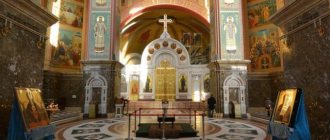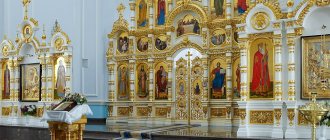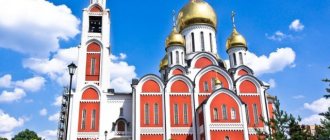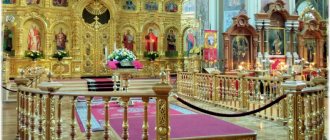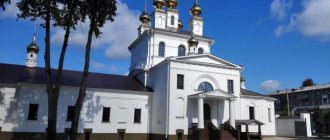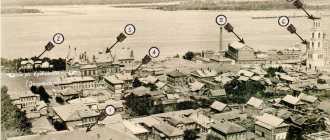The Vologda Resurrection Cathedral is an architectural monument of federal significance, located in the bishop's courtyard and part of the architectural ensemble of the Vologda Kremlin. The cathedral was originally created as a “warm” cathedral, that is, intended for worship in winter.
The Resurrection Cathedral was first built in the middle of the 18th century, but recognizing its lack of reliability, it was quickly dismantled. The surviving stone temple was built in 1776. During its construction, the stone of one of the Kremlin towers was actively used, on the site of which large-scale construction took place. The result was an impressive two-story, five-domed cathedral.
During the time of Alexander I c. The cathedral has an Empire style entrance, and numerous columns in the Italian style were included in the project almost from the very beginning. At the same time, the creation of the main entrance was the only modification to the building over the many years of its existence, so it managed to maintain its original appearance.
Main altar of the Resurrection Cathedral, © Alexey Sorokin
Cathedral architecture
The cathedral is a building 2 floors high, oval in shape with five chapters. Inside, the building is equipped with a refectory and four chapels (two on each side). The cathedral is crowned with a dome with oval windows. There are two-tiered octagonal towers around the dome.
The facades of the cathedral are decorated with Tuscan columns and pilasters. The traditional Russian northern style is visible in the figured platbands on the windows. The main entrance is framed in the Empire style.
© Dmitry A. Shchukin
In the current museum-reserve there is a wooden model of the cathedral, which has significant differences from the original design, which indicates that the builders have departed from the original plan. The implemented project is distinguished by its architectural simplicity and straightness of form. Experts note that the appearance of the object does not correspond to the ideas of classical baroque. It is suggested that the construction of the cathedral was carried out under the leadership of one of the St. Petersburg architects. The interior of the cathedral was almost completely redesigned in the 19th century.
View from the bell tower of the cathedral to the square, © Denis Komarov
Abbots, clerics
- Theodore Kazansky (mentioned beginning 1922 - 1923)
- Ignatius (Deputies) (November 6, 2014 [3] - August 3, 2015)
- Sergius (Akimov) (February 19, 2015 [4] - August 3, 2015)
…
- Alexy Bulekov (August 3, 2015 [7] – June 1, 2017)
- Andrey Fomin (June 1, 2022 [9] - December 26, 2017)
- Sergiy Zyablitsky (from December 26, 2022 [10])
Shrines of the Resurrection Cathedral
The main shrine of the cathedral is not in the temple itself, but in the museum complex of the Vologda Kremlin. It is the ancient icon “Trinity of Zyryansk”, dated to the end of the 14th century. The author of the icon is unknown. Despite the fact that this is a rare example of medieval Orthodox icon painting, this is not the fact that the icon is valuable. The main uniqueness of the shrine is the inscription at the bottom of the icon, made in the Komi-Zyryan language. To create the inscription, the ancient Permian alphabet was used, which was based on runes, Cyrillic and the Greek alphabet. Since the painting is very ancient and is considered fragile, the icon is not permanently displayed. Before your trip, check with the museum administration about its display.
Cathedral of the Nativity of the Blessed Virgin Mary today
The temple building was erected in honor of the birth of the Mother of God, which is why it got its name. It has the status of a functioning Cathedral.
Services are conducted in Church Slavonic. The building was built to strengthen Orthodoxy on Vologda land and today is its stronghold in this region. The cathedral is visited annually by thousands of believers in the Vologda region and surrounding regions of Russia.
The parish of the temple is located on Govorovsky Ave., building 2A.
How to get to the Resurrection Cathedral in Vologda
The Resurrection Cathedral is located in the heart of the historical part of the city - on the territory of the Vologda Kremlin, opposite the Church of Alexander Nevsky, located on the shore of Vologda. The surroundings of the cathedral are full of attractions, gardens and squares. There are 2 public transport stops at approximately the same distance (400–500 meters):
- Stop "Leningradskaya": buses No. 7, 8, 11, 16, 22, 27, 29, 32, 37, 42, 403, 405.
- Stop “Center (Trading Square)”: buses No. 7, 8, 14, 16, 22, 27, 28, 29, 30, 32, 42.
Vologda public transport schedule
From the railway station and bus station
Vologda-1 railway station and Vologda bus station are a 17-20 minute drive away. You can get to the “Center (Torgovaya Ploshchad)” stop from the railway station by buses No. 28 and 30. The journey on foot will not take much longer - about 20–25 minutes.
Map of the walking route from the Vologda-1 railway station to the Resurrection Cathedral on Google maps. Maps
Thematic Internet resources
Website of the project “Information system about cultural heritage sites of the Vologda region”. During the implementation of the project, information signs containing a QR code and a text part are installed at the sites.
Wikipedia page . List of churches of all religions and denominations located on the territory of the city of Vologda within its modern borders.
Holy places of the Vologda region - on the website of the Vologda Regional Universal Library named after. I.V. Babushkina .
Church history of the Vologda region - on the website of the Vologda Regional Universal Library named after. I.V. Babushkina .
Website of the Venerable Kirill Belozersky
Temples of Vologda on the portal Temples of Russia . The project is dedicated to Orthodox and Old Believer churches. A list of churches and monasteries with brief background information has been compiled within the boundaries of Vologda
Vologda section. All temples and monasteries of the People's Catalog of Orthodox Architecture contains descriptions and photographs of Orthodox churches and monasteries in the city.
The Temples and Churches section on the Nason-gorod contains historical essays about monasteries, temples and chapels of Vologda
Local history literature
Album of views of the city of Vologda: Vol. 1: Cathedrals and bishop's house / Photo by S. Nepein. Vologda, 1898.
Banige V., Pertsev N. Vologda. Moscow, 1970.
Bocharov G.N., Vygolov V.P., Vologda, Kirillov, Ferapontovo, Belozersk. Moscow, 1979.
Vologda in the past millennium: Essays on the history of the city. Vologda, 2004.
Vologda Encyclopedia / ch. ed. G. V. Sudakov. Vologda, 2006.
Dmitrievsky A. Church of the Holy Great Martyr Catherine, in Flerovka in the city of Vologda. Vologda, 1911.
Dunaev B. Northern Russian civil and church architecture: The city of Vologda. Moscow, 1914.
Evdokimov I. Two architectural monuments in Vologda: About the Ilyinsky Monastery and the Church of Varlaam Khutynsky. Vologda, 1922.
Zheleznyak V. Vologda: A short guide to memorial, architectural and picturesque monuments. Vologda: Regional Museum of Local Lore, 1947.
Zasetsky A. Historical and topographical news from antiquity about Russia, and partly about the city of Vologda and its district... Ed. the second is corrected and supplemented. Moscow, 1782.
Koval S. Appendix to the plan of Vologda, 1908 (Brief essay about the city). Vologda, 1908.
Komarova V. Chapels of the city of Vologda . // News of the Vologda Society for the Study of the Northern Territory. Vol. IX. Vologda, 2001.
Konovalov F. Ya., Panov L. S., Uvarov N. V., Vologda. XII - early XX centuries. - Arkhangelsk, 1993.
Konoplev N. Spasovsegrad Cathedral in the city of Vologda and its shrines. - Sergiev Posad, 1915.
Malinovsky N. Vladimir Church in the city of Vologda. Historical description. Vologda, 1905.
Lebedev V. Historical note on the state of the Vologda Theological School for a hundred years of its existence and lists of those who served in the school and students who completed a full course in it during the first century (1814-1914). Vologda, 1916.
Lebedev A. Assumption Convent in Vologda and the attributed Nikolaev Ozersk Hermitage. Vologda, 1899.
Chronicle of the city of Vologda (1147-1962). Vologda, 1963.
Lukomsky G.K. Vologda in its antiquity: Description of monuments of artistic and architectural antiquity, compiled and published with the participation of members of the Northern Circle of Fine Arts Lovers. St. Petersburg, 1914.
Nepein S. Vologda before and now. Vologda, 1906.
Nepein S. Brief sketch of the city of Vologda. Vologda, 1905.
Nepein S. Tsarekonstantinovskaya Church in the city of Vologda. Vologda, 1905.
Description of the Spasoobydennaya Vsegradskaya Church in Vologda. Ed. the second is corrected and supplemented. Vologda, 1879.
Pakholkov X. The city of Vologda and its surroundings (with the application of a city plan). Vologda, 1896.
Savvaitov P. Description of the Vologda Spaso-Kamensky Spiritual Monastery. St. Petersburg, 1860.
Savvaitov P. Description of the Vologda Spiritual Monastery, compiled in 1860 by P. Savvaitov, corrected and supplemented in 1885 by I. Suvorov, in 1912 by I. Suvorov. Vologda, 1912.
Sazonov A.I. My Vologda. Walking around the old town. Vologda, 2006.
Sazonov A.I., Starikov E.A. My Vologda. City of our memory. Vologda, 2007.
Collection of history of the old streets of the city of Vologda / Vologda Regional Museum of Local Lore, section of veterans of the revolution and civil war: typescripts, text. Vologda, 1970.
Sluchevsky K.K. In the North-West of Russia. Second edition. T. 2. St. Petersburg, 1897.
Sokolov V. Vologda: History of construction and improvement of the city. Vologda, 1977.
Spasenkova I.V. The Orthodox tradition of the Russian city in the 1917-1930s (based on materials from Vologda): Dissertation for the degree of candidate of historical sciences. 07.00.02 - Russian history; 07.00.07 - ethnography, ethnology and anthropology / Vologda State Pedagogical University. Vologda, 1999.
Spasenkova I.V. Ethno-confessional traditions of the Russian city (based on materials from Vologda 1920-1930) // Regional studies in the European North. Vologda, 2007
Old Vologda, XII - early XX century: Sat. document and materials. Vologda, 2004.
Stepanovsky I.K. Vologda antiquity (historical and archaeological collection). Vologda, 1890.
Suvorov N. Description of the Vologda Cathedral of St. Sophia. Moscow, 1863.
Suvorov N. Description of the Spasoobydennaya Vsegradskaya Church in Vologda. Second edition, corrected and expanded. Vologda, 1879.
Suvorov N. Guide to Vologda with an indication of its church antiquities and shrines and other attractions. Vologda, 1874.
Fechner M. Vologda. Moscow, 1958.
Church-historical atlas of the Vologda region. Vologda - Moscow, 2007.
Interior decoration
The classic interior content of the temple consists of walls and temple icons painted on church themes. The interior doors have been preserved since the construction of the temple.
They have applied copper flowers and 3D diamond details as decoration. The walls are painted in soft shades of green and yellow, and the lighting is electric. There is an iconostasis made in the form of a wooden structure with niches and shelves.
History of foundation, construction
In the second half of the 18th century. In Vologda, by order of Catherine II, in order to combat epidemics, a new separate cemetery was created outside the city limits, which was called Bogorodskoye. Soon a stone church was built near the cemetery. The city's population was constantly growing and soon the building was insufficient to accommodate all the parishioners.
In 1832, city mayor A.I. Popov-Testov was asked to lay a new building for the cathedral, which would be more spacious and capacious. It is this that has survived to this day. In 1836, construction was completed and the building was illuminated. In the beginning. In the 20th century, thanks to the efforts of the city warden of the church, Nikolai Kubryakov, the cathedral building underwent some changes - the entrance to the 2nd floor was redone and the refectory was extended.
Cathedral of the Nativity of the Virgin Mary in Vologda. Photo from the late 19th century
The Bolshevik victory had a strong impact on all the religious buildings of the former empire. The Cathedral of the Nativity of the Blessed Virgin Mary was no exception - items of church utensils of even slight value were subject to confiscation in favor of the Soviet state. During the Volga famine, local clergy provided all possible assistance to those in need, sharing food and things with them.
By 1927, after the second floor was closed, a renovation community was created in the church, where 7 priests served. It united parishioners from all over the area. As part of the fight against the ministers of the Christian Church and religion, by 1937 the Bogoroditskoye cemetery was completely closed, and the clergy were detained by NKVD officers.
By the 40s, the cathedral remained the only functioning temple in the Vologda region. As the Nazis moved deeper into the territory of the USSR, more and more people began to come to him for repentance and prayers, for hope and faith in victory. This became the reason for the opening of the second floor of the temple and the restoration of its work. However, after the end of the war with Germany, the cathedral was closed again.
After the collapse of the USSR, the attitude of the State towards the Church changed sharply, a “thaw” came and the Russian Orthodox Church began to actively restore the building.
